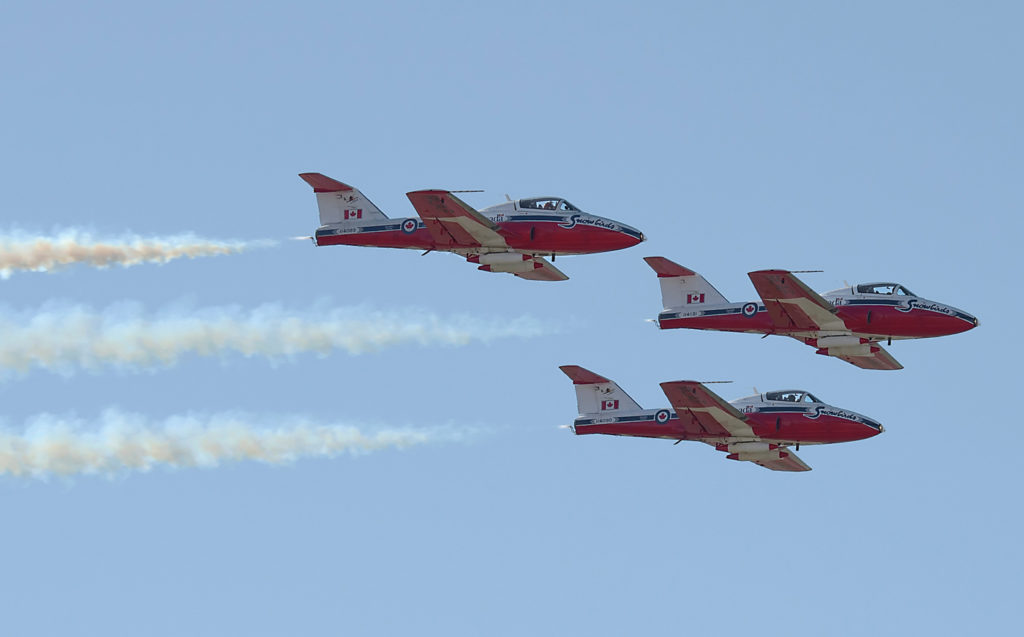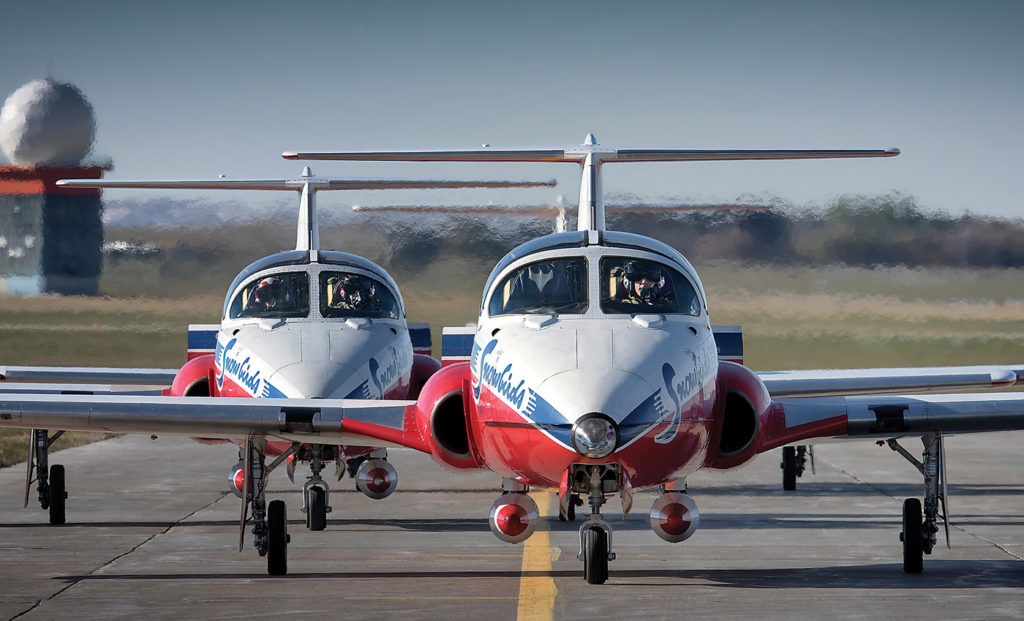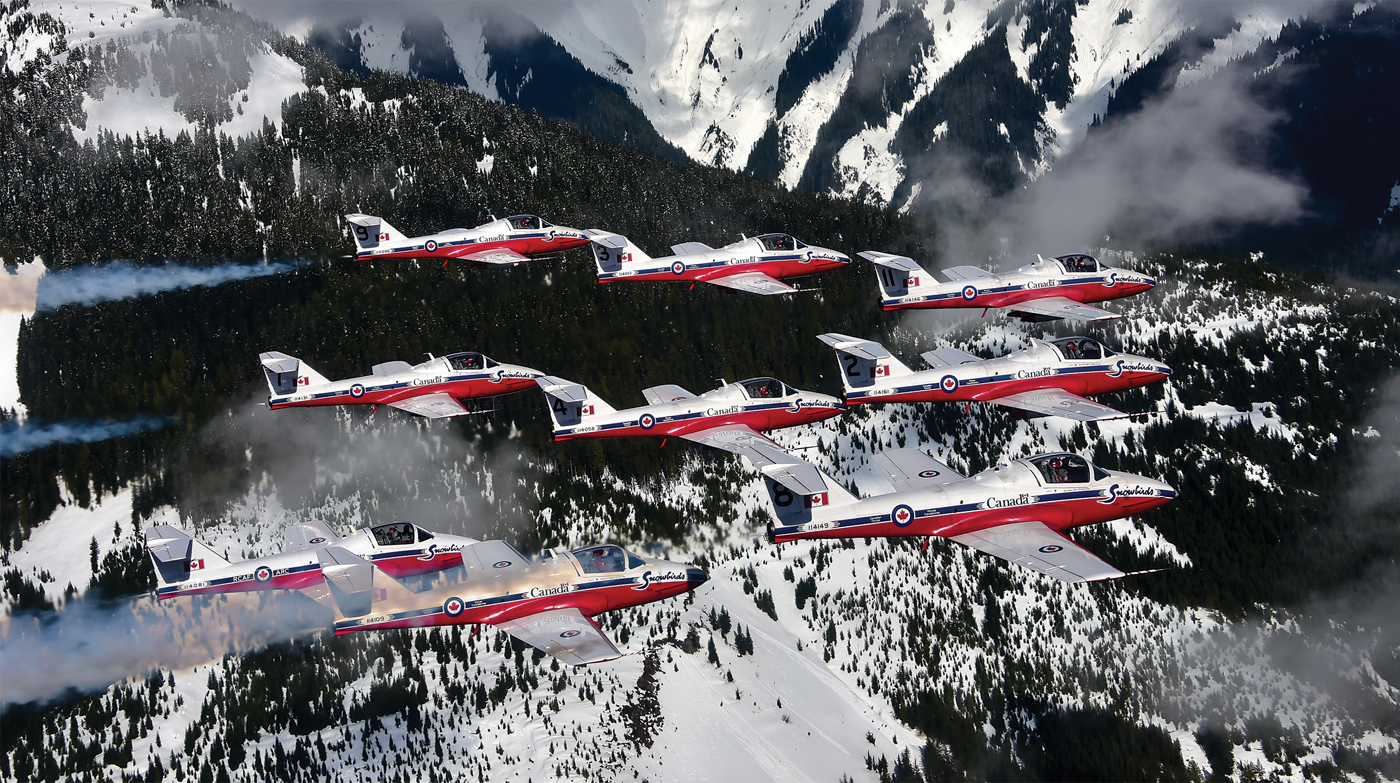Estimated reading time 9 minutes, 32 seconds.
While the Canadian Forces Snowbirds are a household name with airshow goers and aviation fans around the world, many have not had a behind the scenes look at those who play a big part in bringing you the team each season.

Chances are, if you’ve never heard of the Ops/Standards Cell within 431 Air Demonstration Squadron–or the Tutor SET–you’re not alone. There are many moving parts to any successful show season for the Snowbirds, many of which are rarely seen by the general public at airshows across North America.
Ops/Standards Cell
One of those unseen elements of the Canadian Forces Snowbirds is a small group of 431 Squadron pilots known as the Ops/Standards Cell. This year, the group includes deputy commanding officer and unit instrument check pilot (ICP), Maj Patrick Gobeil, and operations officer, Capt Philippe Roy.
While there is no special selection process involved in joining the Ops/Standards Cell, each candidate must pass a Snowbirds Standards Instructor Pilot (SSIP) test. Ex-show pilots are preferred since they have the unique and valuable experience required to aid in the training and proficiency of the team’s current roster of pilots.
Gobeil, a native of Longueuil, Que., trained on the Tutor while coming up through the Royal Canadian Air Force (RCAF), an increasingly rare credential among today’s Canadian military pilots.
He tried out for the team and made the cut with the 2005 and 2006 Snowbirds as the outer right wing pilot in the No. 6 jet. In 2012, he was selected for the role of CF-188 demonstration pilot in the “True North, Strong and Free”-themed jet before making a return to the Snowbirds for the 2014 and 2015 seasons after being selected to be the new boss (team lead).

In 2016, after two safe and successful years, Gobeil turned the lead of the team over to the new boss, Maj Yanick Grégoire, and would remain with the squadron as deputy commanding officer (DCO), leveraging his immense skill, experience and over 4,600 military flying hours.
Roy, from Gatineau, Que., came to the team with a military flying career as both a Harvard II flight instructor with 2 CFFTS, also known as the “Big 2,” and a search and rescue pilot on the CC-130 Hercules. Roy tried out for the team in 2013 and was selected to fly the No. 4 jet in the first line astern position, who along with the second line astern (No. 5 jet), are affectionately known as “Stemcats.”
Roy flew the No. 4 jet for three seasons, from 2014 through 2016, and relinquished the position to new team member, Maj Andy Feltrin.
Unlike times past, most pilots who try out for the Snowbirds today come to the squadron without ever having any formal training or flying time in the older, yet reliable, Canadian-made CT-114 Tutor aircraft.
For those pilots, this is where they’ll get their first hands-on experience with the Tutor, flying with senior members of the team and pilots from the Ops/Standards Cell. Successful candidates will report to the team in July and begin the type conversion process through various check rides (flights) such as instrument, proficiency and formation.
They’ll fly these check rides with the Ops/Standards Cell and will continue to train with them through the summer months in Moose Jaw, Sask., while the team is on the road. Once Tutor type conversion is complete, the new Snowbirds are prepared for the long winter months ahead, where they will train with the rest of the team. Standards pilots will fly with members of the team prior to their spring training deployment in Comox, B.C., to “reset” their instrument tickets (ratings) and then take turns accompanying the team in Comox while they work through the formation checks for each of the pilots leading up to the start of the show season.

While not an actual role of the Ops/Standards cell, in some situations, the pilots could be called upon to step in for senior members of the team during the early stages of their training to reduce any potential gaps. This is however a rarity once the team gets to more advanced flying in January.
This past winter, the team experienced an extreme anomaly when Gobeil was called upon to temporarily step in as team lead for Grégoire. Grégoire was undergoing a surgical procedure that as a result (with his pilot medical category) would prevent him from flying high-performance aircraft until fully recovered.
It was good fortune that 431 Squadron still had Gobeil in the fold as the DCO who was still actively flying the Tutor. As a former and very recent team lead, Gobeil was able to lead the team through the remaining winter months in Moose Jaw, followed by spring training and then a subsequent additional training period in May.
Because training must flow with as little interruption as possible, the squadron relies on its Standards pilots to deliver a high level of support to not only the team members, but the fleet of aircraft as well.
Test flights must be done following maintenance on the aircraft, which are especially important during the winter months when serviceable aircraft for training flights are at a premium. At times, aircraft need to be flown from the Snowbirds’ home at 15 Wing Moose Jaw to 8 Wing Trenton, Ont., for “periodic maintenance,” which every aircraft receives after 400 hours of flying time.
There are different overhaul requirements depending on where each aircraft is in its lifespan, and because 431 Squadron is busy training Tutor technicians, that “periodic maintenance” is contracted out.
During the show season, jets may need to be swapped out for reasons such as mechanical issues which require more support than the team has available to them on the road. Pilots from the Standards Cell handle the task of getting those jets to the team and, if safe to do so, flying the aircraft in need of extra maintenance back to Moose Jaw.
1 CAD Tutor SET
1 Canadian Air Division (1 CAD) is the source of air assets provided by the RCAF to the operational command of the Canadian Forces (CF). With 1 CAD Headquarters based in Winnipeg, Man., there’s a need for eyes and ears on the ground (and in the air) with the Snowbirds, both at home in Moose Jaw and on the road. That responsibility goes to the 1 CAD Tutor Standards, Evaluation and Training (SET) officer, Capt Brent Handy.

Handy, a former CF-188 Hornet pilot, tried out for the Snowbirds while flying as a CT-155 Hawk instructor at 419 Tactical Fighter Training Squadron. He joined the team for the 2012 and 2013 seasons as opposing and then lead solo in the No. 9 jet, he continues to fly airshows as a solo aerobatic performer in his Pitts aerobatic plane and recently represented the RCAF in Vimy, France as one of five pilots to fly replica First World War biplanes over a ceremony commemorating the 100th anniversary of the Battle of Vimy Ridge.
He has over 3,600 hours of military flying time. As a former solo, Handy is also a valuable asset to the Ops/Standards Cell as he can speak with authority on the formation and solo manoeuvres, whereas a wing pilot (for example) would lack the relevant experience to provide useful feedback to a lead solo regarding those procedures.
With the Tutor SET being co-located on base with the Snowbirds, Handy is well positioned to augment the squadron with routine pilot training flights and check rides, in addition to his regular duties. The SET role is like the standards cell for the Air Force, with the responsibility to report and advise to the air division commander on matters pertaining to fleet and pilot readiness.
The SET also vets changes to procedures and regulations brought forward by the squadron before the commanders sign off on them at 1 CAD HQ. Handy prepares annual ground exams and conducts check flights for the pilots. He also conducts an OSV (operational standards verification, or audit) twice a year, once during spring training and once more during the summer. As the SET does not fall under the jurisdiction of the squadron, Handy is also the only one who can do the commanding officer’s check flight and sign off on new standards pilots who have completed the SSIP.
As airshow spectators and fans of the Snowbirds, we are treated to outstanding performances across North America. We marvel at the formation changes that occur during looping manoeuvres. We cheer for nine-plane bursts and head-to-head solo passes. All of this is brought to us by the many talented people at 431 Air Demonstration Squadron, including their hard-working technicians and support personnel at home.
The show must go on, and year after year it does, thanks in large part to the high-level training and support received by the talented members of the Ops/Standards Cell and the Tutor SET.
Mike Luedey is a Langley, B.C.-based aviation photographer who got his start volunteering time with aviation museums in the Pacific Northwest, leading to an active role
with airshows and the military. Mike’s focus has shifted to photojournalism, allowing him to further share his passion for aviation and those he’s met through it.

